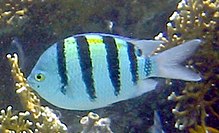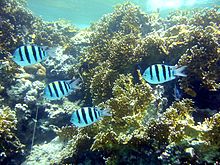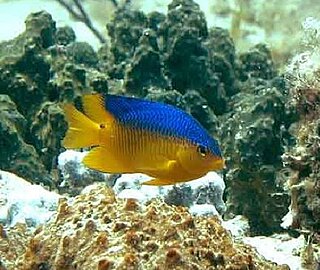
Pomacentridae is a family of ray-finned fish, comprising the damselfishes and clownfishes. This family were formerly placed in the order Perciformes but are now regarded as being incertae sedis in the subseries Ovalentaria in the clade Percomorpha. They are primarily marine, while a few species inhabit freshwater and brackish environments. They are noted for their hardy constitutions and territoriality. Many are brightly colored, so they are popular in aquaria.

The sergeant major or píntano is a species of damselfish. It grows to a maximum length of about 22.9 centimetres (9.0 in).

Abudefduf, also known as the sergeant-majors, is a genus of fish in the family Pomacentridae.

The marbled parrotfish, also known as the seagrass parrotfish, is a species of marine ray-finned fish, a parrotfish from the family Scaridae and is the only known member of the genus Leptoscarus. It has a wide Indo-Pacific distribution and is also found in the southeastern Atlantic Ocean. It is a coastal species found in beds of sea grass and seaweed.

Stegastes nigricans, the dusky farmerfish, is a species of damselfish found around coral reefs at a depth of one to 12 meters, in tropical climates between 30°S and 30°N. They are known for farming monocultures of algae such as cyanophores and rhodophytes.

The scissortail sergeant or striptailed damselfish is a large damselfish. It earns its name from the black-striped tail and sides, which are reminiscent of the insignia of a military Sergeant, being similar to those of the sergeant major damselfish. It grows to a length of about 16 centimetres (6.3 in).

The green damselfish, also known as the Hawaiian sergeant major, is a non-migratory fish of the family Pomacentridae. It occurs in the Pacific Ocean in the vicinity of the Hawaiian Islands, Midway Island and Johnston Atoll. It can grow to a maximum total length of 30 cm.

Pomacentrus coelestis, the neon damselfish, is a species of damselfish in the family Pomacentridae. It is found in the Indo-Pacific. It can grow to a maximum size of 9 centimetres (3.5 in) in length. It occasionally makes its way into the aquarium trade.

Ctenochaetus striatus, the striated surgeonfish, lined bristletooth, fine-lined bristletooth or striped bristletooth, is a species of marine ray-finned fish belonging to the family Acanthuridae, the surgeonfishes, unicoornfishes and tangs This species has a wide Indo-Pacific distribution.

The honeycomb grouper, also known as black-spotted rock-cod, common birdwire rockcod, dwarf spotted rockcod, dwarf-spotted grouper, honeycomb cod, wire-netted reefcod or wire-netting cod, is a species of marine ray-finned fish, a grouper from the subfamily Epinephelinae which is part of the family Serranidae, which also includes the anthias and sea basses. It has a wide Indo-Pacific distribution where it is found in coastal and offshore reefs in shallow waters.

Abudefduf troschelii, the Pacific sergeant major or Panama sergeant major, is a species of damselfish belonging to the family Pomacentridae that can be identified by the pronounced black stripes on the lateral sides of the fish. Its specific name honors the zoologist Franz Hermann Troschel (1810-1882). It is native to the neritic pelagic zone of the shallow water coral reefs in the Eastern Pacific Ocean and they are an omnivorous species feeding on plankton and algae attached to their coral habitat. Abudefduf troschelii is a sister-species of A. saxatilis but have diverged from each other since the uplift of the isthmus of Panama, separated by the rise of the Panama land bridge 3.1 to 3.5 million years ago. Males, like in many other marine species, take care of and defend newborn A. troschelii after they have been hatched by eggs from the female. There are currently no major threats to the species and there is no indication of a current decline in its population size. The IUCN Red List lists this damselfish as being of “least concern”.
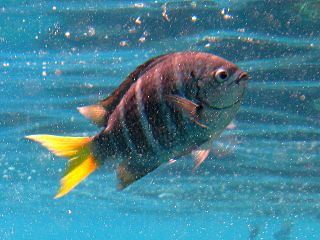
The yellowtail sergeant is a species of damselfish in the family Pomacentridae native to the Indo-Pacific. It can grow to a maximum total length of 17 centimetres (6.7 in).

The fusilier damselfish is a species of damselfish in the family Pomacentridae. It found in the Indo-Pacific. They are found in the aquarium hobby. Adults can grow up to a maximum length of up to 10.5 centimetres (4.1 in). It is the only species in the monotypic genus, Lepidozygus which sits in its own subfamily, the Lepidozyginae.
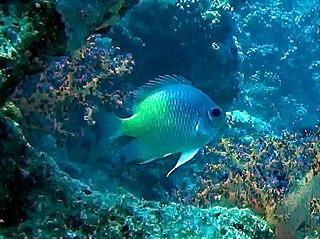
Amblyglyphidodon flavilatus, known as yellow damselfish, yellowfin damselfish, yellow flank damselfish, yellow side damselfish, and yellow-sided Damselfish, is part Pomacentridae, which is a family of ray-finned fish including damselfish and clownfish. This family represents the greatest diversity and abundance of fish species inhabiting coral reefs. They were first discovered in the 1980s by Allen and Randall.

Abudefduf septemfasciatus, commonly known as the banded sergeant, is a species of damselfish in the family Pomacentridae. The species is native to the Indo-Pacific and can reach 23 cm in total length.

Kyphosus vaigiensis, the brassy chub, brassy drummer, long-finned drummer, low-finned drummer, Northern silver drummer, Queensland drummer, Southern drummer, blue-bronze sea chub, brassy rudderfish, yellow seachub, large-tailed drummer, low-finned chub or long-finned rudderfish, is a species of marine ray-finned fish, a sea chub from the family Kyphosidae. It is a largely herbivorous species which has a circumglobal distribution. Studies in the 21st Century appear to have shown that some other species in the genus Kyphosus are junior synonyms of this taxon.
Epinephelus geoffroyi, the Red Sea spotted grouper, is a species of marine fish in the genus Epinephelus in the grouper family. The species was first described in 1870. E. geoffroyi was previously considered a synonym of Epinephelus chlorostigma, but Randall et al. recognized it as a valid species in 2013.

Abudefduf bengalensis, known as the Bengal sergeant or the narrow-banded sergeant major, is a species of damselfish in the family Pomacentridae. It is a marine species native to the tropical Indo-Pacific, where it ranges from the eastern Indian Ocean to Australia and Japan in the Pacific Ocean, and it is not known to occur in the Red Sea. Adults of the species are typically found in coral reef and lagoon environments at a depth of 1 to 6 m, where they typically occur singly or in small groups.
Abudefduf nigrimargo, known as the black margined-scale sergeant or Taiwanese sergeant, is a species of damselfish in the family Pomacentridae. It is native to the northwestern Pacific Ocean, where it is known only from Taiwan. The species is known to occur above shallow rocky reefs, where it forms feeding aggregations. The habitat in which Abudefduf nigrimargo can be found is also known to be inhabited by the related species Abudefduf vaigiensis and Abudefduf caudobimaculatus. The species reaches 12 cm in standard length.
Abudefduf caudobimaculatus, commonly known as the Okinawa sergeant, is a species of damselfish in the family Pomacentridae. It is native to the Indo-Pacific, where it is believed to range from East Africa to Yakushima and Lord Howe Island, including Taiwan and Indonesia. Although initially described in 1939, it was subsequently considered synonymous with Abudefduf vaigiensis, until a 2017 review conducted by Kunto Wibowo of the Indonesian Institute of Sciences, Hiroyuki Motomura of the Kagoshima University Museum, and Minoru Toda redescribed it as a valid and distinct species. Despite this, it is still listed by FishBase, IUCN, and WoRMS as a synonym of A. vaigiensis.
